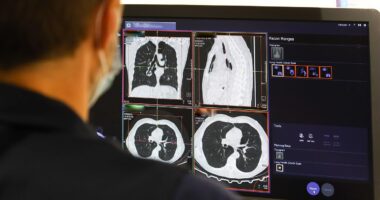There are certain parts of the body that set off instant alarm bells if they experience changes or become painful.
Constant headaches, fever, diarrhoea and vomiting, for example, are all symptoms that typically spark further investigation.
However, other parts of our anatomy can sometimes go by unnoticed. Toes are one such part.
According to Doctor Naheed Ali, physician and medical writer for Sweat Block, we should be “listening closely” to what they’re telling us.
Speaking exclusively to Express.co.uk , he said: “As a physician having treated countless foot woes, I often say when toes talk with unusual signs – like numbness, tingling, or swelling – it pays to listen closely.
“Catching emerging issues early makes all the difference. What may seem like benign foot fuzziness could prove a red flag for systemic disease.
“Even common problems like runner’s neuropathy delivering pins-and-needles discomfort warrant prompt evaluation.
“When feet send distress signals, it is prudent we investigate why right away. Our toes provide an insightful well-being snapshot – by tuning into their messages and language, we obtain vital clues to preserve mobility and wellness longer.”
With this in mind he revealed three important symptoms in the toes to get checked out:
- Tingling and numbness
- Swollen, inflamed toes
- Painful toenails.
Tingling and numbness
This occurs when nerve fibres get irritated or compressed.
Dr Ali said: “Causes range from high blood sugar to nutritional deficiencies to nerve damage. If both feet display symptoms, systemic origins become more likely.
“Rapid onset warrants prompt care to treat potential stroke or nerve entrapment.”
Swollen, inflamed toes
Swollen, inflamed toes that turn purple, known as dactylitis, should raise “significant concern”, he said.
He continued: “This condition suggests the possibility of inflammatory arthritis, gout, or even more serious issues.
“Infections, particularly those transmitted through food, can also lead to severe swelling in the toes.
“Rapid swelling in a toe, indicating localised inflammation, necessitates urgent medical attention.”
Painful toenails
“Don’t dismiss painful toenail changes either – thickened, distorted nails that are hard to trim may indicate psoriatic disease,” he said.
“This systemic autoimmune disorder can also lead to arthritis, which may result in joint damage if left untreated.”
He added: “Sudden symptoms in individuals over 50 should be carefully evaluated, as they may indicate underlying diabetic or cardiovascular diseases.
“Additionally, be aware of peripheral artery disease (PAD), which can also manifest in the feet. PAD is a condition that results from blocked arteries in the legs and can signal broader cardiovascular problems.”
Dr Ali advised consulting a podiatrist or doctor “right away” if you notice any unusual toe or foot changes occur.










